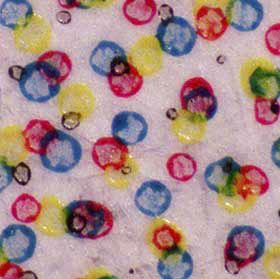
ANNOUNCEMENT: RIT offers PRINT PROCESS IDENTIFICATION COURSE - November 18-21, 2008 and June 16-19, 2009
The image is a muted version of what a document examiner might see through a microscope during the examination of a document printed with "Letterpress." To be able to identify printing processes, the examiner must first learn:
1. some basic theory about "non-impact" printing processes
2. how the various printing processes are accomplished
3. what are the important parts of the various printing presses
4. what type of media, or "substrate" are compatible with the process
5. what type of "ink" is compatible with the process
6. how these factors work together to create a printed document
7. what characteristics would be seen under magnification as signs of each printing process.
Following through with our example, in Letterpress, the printing "plate" has two areas, and one is raised above the other. The area that is raised contains the information that is to be printed. When colorant ("ink") is spread onto the plate, it must be kept in the raised area only, or there will be printing where there should be none. The inked plate passes through a printing "nip" where presure forces it against the substrate (often, but not always, this is paper). Due to the nature of the materials and process involved, the pressure forces some of the colorant to the outside of each "cell" of the plate, resulting in a "squeeze-out" effect in which the center of the printed cell has less density of colorant, and the perimeter has a greater density of colorant. When the examiner looks through the microscope, the image may look like a brighter, crisper version of this background.
While this example is somewhat simplified, in general this is how print process identification is done. The examiner understands the process and materials and knows what the results of the process should look like under magnification. The examiner also works with reference books that diagram and explain the printing processes and keeps a library of images as benchmarks of the various printing processes.
An excellent seminar in Print Process Identification for Forensic Document Examiners is offered at Rochester Institute of Technology. The image for this page were captured by one of the seminar instructors, RIT professor Milton Pearson, and is used here with his permission. Thanks, Milt!
Copyright © 2001-2008 Emily J. Will All Rights Reserved.
